Featured Stones 2005-2008
Pala International’s Featured Stones – 2008
Featured in Pala’s Gem News. All photographs by Wimon Manorotkul except as noted.
See other:
- 2014–2015 Featured Stones
- 2009–2013 Featured Stones
- 2005–2008 Featured Stones – Scroll down
December 21, 2008: Winza Rubies Come to Pala
A new source for rubies has brought some renewed excitement to the gem world. Tanzania has been a hot spot for new gem deposits recently; from the giant Mahenge spinel crystal, to the massive Loliondo spessartite garnet find, to the exquisite rubies from Winza. The Winza rubies were first discovered about a year ago and the most recent news from the source is that production has slowed down of late.
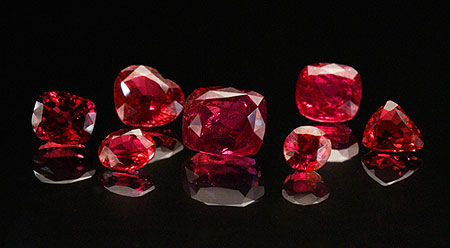 |
| A selection of rubies from Winza available from Pala International. (Photo: Mia Dixon) |
These bright and intense natural rubies have a different character than the largest historical Burmese source, but they can have a beauty unto themselves. Since Burma is no longer a legal source for new ruby material imported into the U.S., the Winza rubies came along just in time to satisfy the hunger of collectors. In general the finest Burmese still hold the “pigeon’s blood” trophy, but the Winza rubies define a new category of vibrancy and intensity.
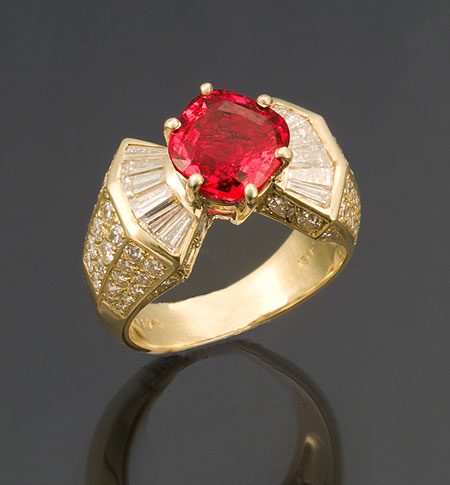 |
| This 3.18-carat ruby from Winza demonstrates the limpid yet lively quality of this Tanzanian material. (Photo: Mia Dixon) |
The material is vivid, slightly pinkish-red, and glows or fluoresces under most light sources. Relatively eye-clean stones are quite rare and contain diagnostic inclusions, such as the arcing needle-like type we reported on in September. We also linked to reports by several gem labs.
Pala is excited to offer a selection of these new rubies. Please call or email us to inquire. [back to top]
November 19, 2008: Gem Sugilite and Neon Green Sphene
Gem sugilite from South Africa
We can credit professor Ken-ichi Sugi, petrologist, for the naming of sugilite at the time of its initial discovery in southwest Japan in 1944.
Gem- and jewelry-quality sugilite now mainly comes from the Kuruman manganese fields of southern Africa. This unusually fine sugilite, featured below, most likely came from the Wessel mine in the Northern Cape Province of South Africa in the Kalahari desert near the country’s northern border with Botswana.
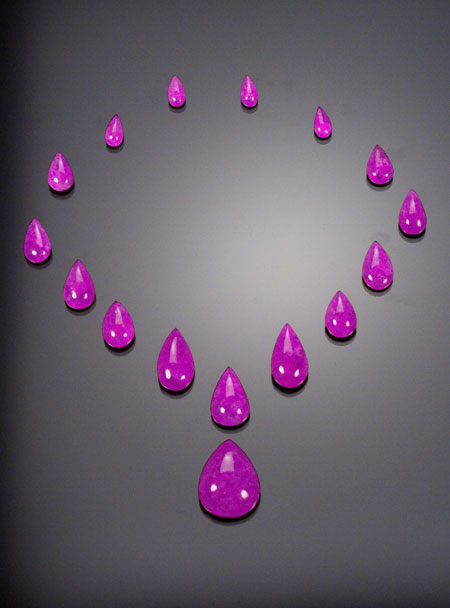 |
| Sugilite suite. Sixteen pieces from 11 x 6 to 24.5 x 19 mm. Total weight 96.46 carats. Inventory #16876. (Photo: Mia Dixon) |
We bought the rough for these gems at this year’s Denver mineral show and cut the material recently. Bill Larson actually split the piece of rough with a meteorite from an adjacent booth in order to concentrate the best material for cutting.
We were pleasantly surprised by the intense fuchsia color and the exceptional transparency of the material. Many have said the color and quality is the best they’ve ever seen in sugilite.
Interested? Select the inventory number above, call, or email us.
Neon Green Sphene from Madagascar
Is this for real?
The dispersion and scintillation of sphene tops off the scale for gemstones. A dazzling display of light and color, like a psychedelic kaleidoscope. These amazing optical properties actually stem from a completely natural source, and are accentuated when a stone is cut appropriately.
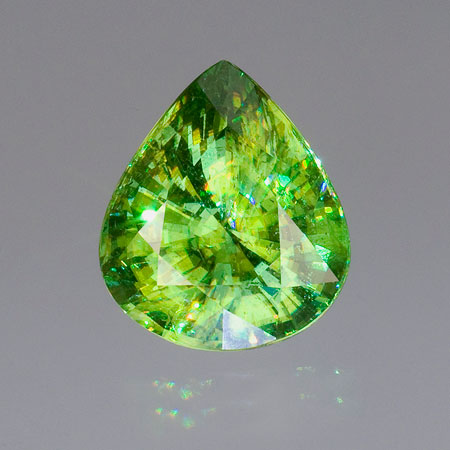 |
| Natural green sphene,16.28 carats, 17.3 x 14.96 x 10.4 mm. This stone has been sold. (Photo: Jason Stephenson) |
This month’s feature is definitely a prodigious example of sphene’s unusual character. Beyond that the rare neon-green body color sends it into another orbit of energy and beauty. In other words, this sphene is alive. [back to top]
October 22, 2008: Melo Pearl
Jewel from the seas of Vietnam
This month we feature a melo pearl that might even impress the Bailer sea snail community. This exquisite natural pearl is still probably being talked about in the waters off the coast of Vietnam.
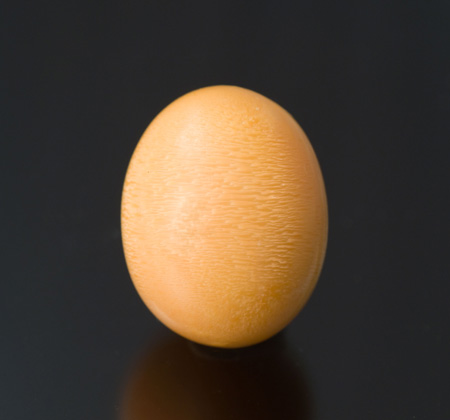 |
| Golden egg. Vietnamese melo pearl, 75.07 carats, 25.05 x 19.35 mm. Inventory #16801. (Photo: Mia Dixon) |
The size and quality of this pearl ranks up there with the best of them, exhibiting a mesmerizing flame pattern, known as “dragon’s breath,” in a pleasing, oval egg shape. Definitely one for the record books, with desirable orange body color and a form that is ripe for the picking as a source of inspiration for a jewelry designer or a natural pearl collector.
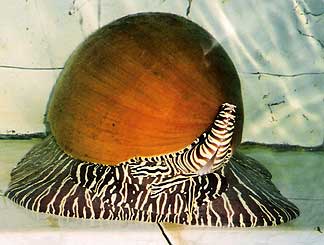 |
| Pearl poppa. A proud Bailer sea snail like this one must have died with a smile on his face knowing he had produced such a wonder of nature. Bailers are used for their shells and for food, with melo pearls being as rare as one in several thousand snails, according to this article by Pala’s Bill Larson et al. (Photo courtesy Pala International supplier) |
Interested? Select the inventory number above, call us, or email us. [back to top]
September 21, 2008: Pink Tourmaline Suite
Vintage Ensemble from the Mesa Grande Mining District
Pala’s Bill Larson recalls dealing with collectors Jim and Mary Dyer in the 1960s. They would visit Pala with Josie Scripps on their return to San Diego County from Brazil. Bill remembers with excitement a large aquamarine find that filled the Dyers’ living room. But the price of $400 for some of the first pieces was beyond most collectors at the time. He did manage to purchase a blue 2 x 1.5-inch frosted gem, terminated crystal for $50, probably worth $1500 today. The prize piece in the Dyers’ collection was a pink tourmaline necklace, ring, and earrings set from the famous Himalaya Mine in San Diego County’s Mesa Grande District (in the possession of Pala International today).
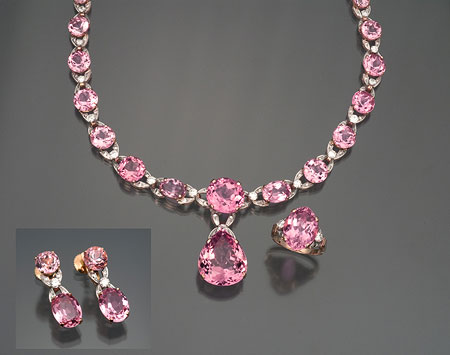 |
| Sweet. This pink tourmaline suite was assembled from material culled at San Diego County’s Himalaya MIne nearly five decades ago. Price: $40,000 for the suite. |
The Dyers got permission to dig in the Himalaya mine’s dumps from owner Ralph Potter. They eventually dug deep enough to get below the dump and find a layer that contained alluvial tourmalines, washed down over the ages—probably the same layer in which the local Indians found the tourmaline gem nodules that eventually sparked the interest of George F. Kunz to explore San Diego’s gems. The Dyers collected many of these pink tourmaline gem nodules, then brought their self-collected prizes to Brazil where they were eventually cut and mounted into this amazing jewelry set.
Bill reminisces: “The lovely parure consisting of a necklace, earrings, and ring was custom designed and cut, and assembled in Brazil in approximately 1960. They were featured on the cover of Lapidary Journal in September 1960. The suite was displayed at the American Museum of Natural History in New York in 1973.”
Here are the specs on the suite:
- Necklace: Approx. 62 cts. pink tourmaline; approx. 1.6 cts. diamonds; 18-karat yellow gold and platinum
- Earrings: 9.5 cts. pink tourmaline; 18-karat yellow gold and platinum
- Ring: 9.28 cts. pink tourmaline; approx. 0.22 cts. diamonds; 18-karat yellow gold and platinum
Interested? Call, or email us. [back to top]
August 21, 2008: Seeing Purple?
Tourmaline, Garnet, and Sapphire
Our sense of color is amused by optics in a world full of varying moods of light and perception of hues. In the gem world we often spend time trying to describe color over the phone, which can be a daunting task since we all have different palettes of color established in our memory. One person may associate red with a fire engine, but connoisseurs of color will delve past the basic red and see the strong orange modifier within fire engine red. Hence an orangey-red would be one example within the continuous nature of color and how individuals perceive it. Even our computer monitors, if not calibrated correctly, can show distortions in the color of the actual gemstone.
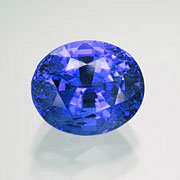 |
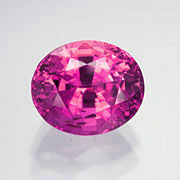 |
| D.I.Y. purple. Open both eyes, stare straight in the middle of the two images (blue and red) then cross your eyes until the two images overlap exactly, producing a purple stone. | |
This month we feature three radiant gems with varying levels of purple, which exhibit subtleties the eye can pick up when we train our brain to evaluate mixtures of color. Purple itself is a mixture of two primary colors, blue and red; try the exercise above to “do it yourself.” The descriptions of the colors that follow may in fact seem askew to someone who has a slightly shifted mental color spectrum then our own.
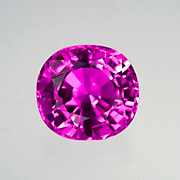 |
| Cuprian tourmaline. This copper-bearing tourmaline from Mozambique weighs 6.82 carats, cushion cut, 12.1 x 11.32 x 7.73 mm. Inventory number 16106. |
Our first gem has a a vivid pinkish purple, which is commonly referred to as fuchsia. The neon color is a product of naturally occurring copper and manganese within this tourmaline from Mozambique.
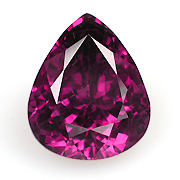 |
| Rhodolite garnet. From Tanzania, 16.98 carats, pear cut, 17.5 x 14.7 x 9.89 mm. Inventory number 5871. |
Our second feature has more of a dark reddish purple, which takes on a raspberry-type color. This unusual color was produced by a garnet found in a one-of-a-kind deposit in Tanzania.
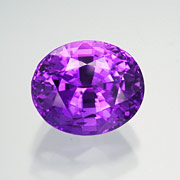 |
| Purple sapphire. Oval cut, 5.25 carats, 10.39 x 8.65 x 6.97 mm. Inventory number 16026. |
Our third feature takes on a fairly recognizable straight purple color in this picture. But an interesting characteristic of this stone is that the color actually shifts in different light sources. See this color shift explanation.
Interested? Select the inventory numbers above, call us, or email us. [back to top]
July 16, 2008: Paraiba-Type Tourmaline from Mozambique
Big & Beautiful
The young and famous Mozambique tourmaline beauties are the talk of the town once again. This time it’s not a question of where they grew up or if in fact they are gorgeous, it’s more about what we can call them. Paraiba-type, paraiba africanas, cuprian elbaite tourmaline, etc… Call them what you want, they’re always in the news because they’re absolutely beautiful, with mesmerizing colors. This month we feature a couple of large ones (Note: The second stone was subsequently sold) to remind everyone how amazing this material is, and why we all fell in love with it in the first place. These two featured stones are the largest to be cut from the parcel of Mozambique rough that was purchased by Pala about three years ago.
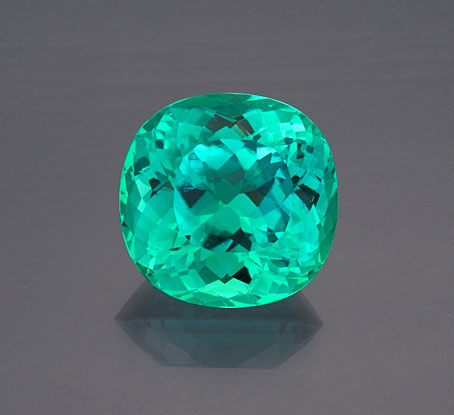 |
| Big & Beautiful I. Paraiba-type tourmaline from Mozambique, 70.74 carats, cushion cut, 25.05 x 24.68 x 18.38 mm. Inventory number 16167. |
The young copper-bearing children of tourmaline heritage have exploded on the runway of gemstones in the past twenty years. Their recent emergence into the gem market from Brazil, Nigeria, and now Mozambique, has been sudden, if we look at the history of tourmaline being described in literature dating back at least 500 years. Their historic parents—the old green, blue, and red varieties—have been overshadowed by the fluorescent neon colors of the next generation of tourmalines.
In the next twenty years, we could quite possibly be seeing the dissemination of the material around the world, and the exhaustion of the deposit in Mozambique. As they say “history will repeat itself,” and new gem discoveries usually are short lived. Sometimes we have to use the past to foreshadow the future, while still enjoying what’s available in the present.
Interested? Call (telephone numbers below) or email us.
See also:
- The Path to Paraiba Winds Through Mozambique and Update
- Paraiba at Pala
- Pala International’s Featured Stone, February 2007 [back to top]
June 19, 2008: Lloviznando Opal
A look above the surface
For in them you shall see the living fire of the ruby, the glorious purple of the amethyst, the sea-green of the emerald, all glittering together in an incredible mixture of light.
— Roman Pliny the Elder on Opal, 1st Century AD
In general when we hear “opal” we think Australia, but there are a few areas in Mexico that produce some of the finest opal with play-of-color on the planet. The exceptional ones also include another dimension of color. When all the components align, a full spectrum of color dances from within the heart of the gem and jumps out of the stone three-dimensionally, almost floating above the surface. The local Mexican miners called the light-and-color dance “floating light” or lloviznando.
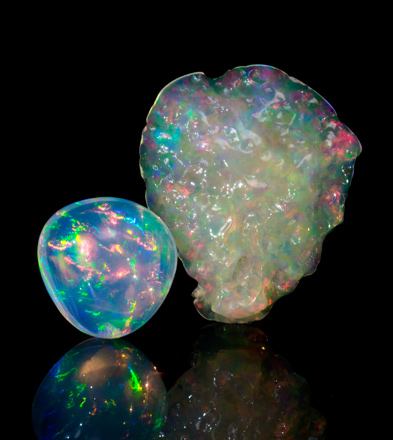 |
| Rough and cut lloviznando opal. Cut: 22.47 carats, 18.97 x 18.3 x 11.97 mm. Rough: 31.66 carats, 35 x 30 x 7 mm. From the Gladnick Collection. These pieces have been sold. |
This month’s feature is by some standards one of the best from the Magdalena mining district in Jalisco, Mexico. A true spectacle of lloviznando: you can actually spin it around in your hands and interact with the play-of-color…
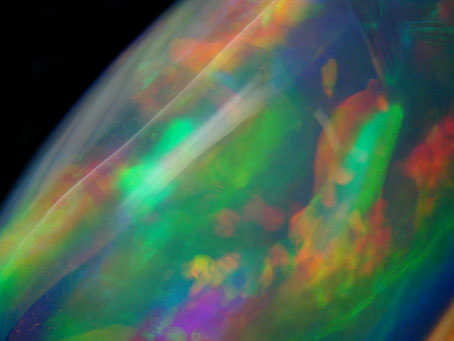 |
| Light rise over Planet Opal. A close-up view of the source of the color in this month’s featured gemstone. From the Gladnick Collection. This stone has been sold. (Photo: Jason Stephenson) |
Read more—and see more—about this month’s featured stone here.
Interested? Call (telephone numbers below) or email us. [back to top]
May 22, 2008: Red Beryl
Can you say Wah Wah?
Well, if you can, you would be on track to start a treasure hunt for the elusive red beryl in southwestern Utah. Find your way to Beaver County and start climbing up the Wah Wah Mountain range. Keep an eye out for white rhyolite volcanic tufts that house the rare little red crystals. Once you find this rock type it’s all about crushing and sorting through the rubble. Be prepared to stay for a while because it’s been estimated that, on average, out of every ton of rock only 0.5 carats of facet grade material is found.
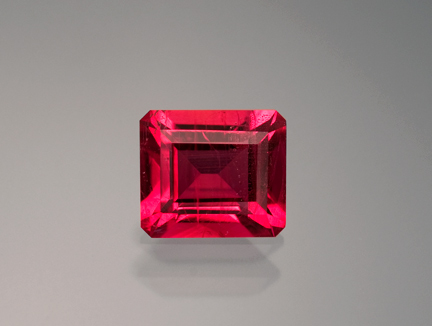 |
| Red beryl. Emerald cut, 1.24 cts., 7.23 x 2.25 x 3.97 mm. Inventory #15614. (Photo: Wimon Manorotkul) |
The average-size faceted stone is under a half carat and usually is included. This month’s featured stone is quite exceptional, weighing in at 1.24 cts. and eye clean. A gooseberry red hue with a pleasant emerald cut showing nice brilliancy.
For more on red beryl, see:
- Two specimens we featured last year at Tucson
- Mindat.org’s entry on red beryl
Interested? Call or email us. [back to top]
April 20, 2008: Sapphire and Ruby
Rough and Cut: From Crystal to Jewel
To stay on topic with this month’s unveiling of our new corundum collection, we though we’d highlight a ruby and sapphire rough-and-cut pair to further appreciate and visualize corundum’s different forms—the speciation of corundum, if you will, from nature’s attempt at crystal perfection to man’s final artistic push to bring out the inner brilliance and color in the faceted form. An intelligently designed crystal with a human touch; the duality of nature and man at its finest.
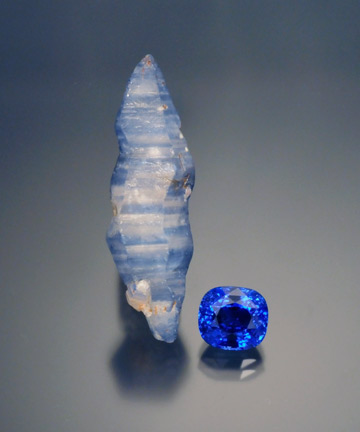 |
| Sri Lankan sapphire pair. The crystal measures 4.3 x 1.3 cm. and weighs 48.23 cts. The faceted gem measures 10.48 x 9.56 x 7.3 mm., weighs 7.13 cts., and is certified natural color from Sri Lanka. Search for the cut stone on inventory number 14737. |
Blue sapphire. A perfect pair showing the classic tapering hexagonal bipyramidal corundum crystal and its sparkling blue faceted counterpart. The white and blue color banding seen throughout the length of the crystal is quite common and often can be seen with magnification from the back of a faceted blue sapphire. The exceptional size and rich, natural royal blue hue of the sapphire definitely classifies this as an upper echelon gem.
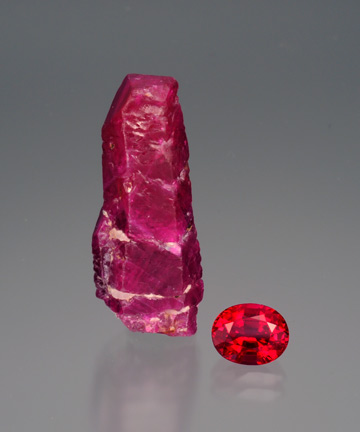 |
| Burma ruby pair. The crystal measures 2.8 x 1.0 cm. and weighs 27.28 cts. The faceted gem measures 7.79 x 6.30 x 4.67 mm., weighs 1.96 cts., and is from Mong Hsu, Burma. The faceted stone has been sold. |
Ruby tends to form in less euhedral crystals, as the perfect symmetry breaks down during formation. This ruby crystal shows the basic hexagonal faces with a rhombohedral termination. Clearly visible are crisscrossing bands of color and small clear pockets interrupted by a network of fractures—probably why the crystal stayed in the natural form and was not able to yield clean stones. The purity of the red hue is seen in the faceted stone, while the crystal shows a more pinkish red. Purity of color is a big factor when evaluating quality; straight red will demand a much higher price than a red with a pink secondary.
Browse the online catalog for blue sapphire and ruby:
Interested? Call or email us. [back to top]
March 19, 2008: Ruby and Sapphire Suites, Cat’s Eye Emerald
This month we go back to the classics: ruby, sapphire, and an emerald with a twist.
Ruby and Sapphire Suites
Two beautiful sets of corundum, red for girls and blue for…well, probably girls, too.
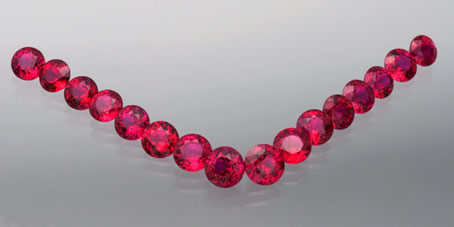 |
| Ruby suite. Sixteen gorgeous, pure and vivid red, round brilliant-cut rubies with a total weight of 16.43 cts. Dimensions range from 5.5 to 6.4 mm. Search on inventory number 13895. |
The limited market on fine quality ruby and sapphire seems to be shrinking as prices keep climbing. Finding a nice matched pair can even be difficult, since most of the time only one stone can be cut from a single piece of rough (because corundum crystals don’t grow very large). Then the process of matching stones by hue, tone, saturation, size, and cut can be a tedious and time consuming task.
So take in the sight of these beautiful suites, which have been accumulated through time and with attention to detail.
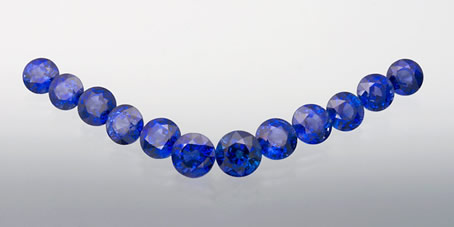 |
| Blue sapphire suite. Twelve beautiful royal blue, round brilliant-cut sapphires with a total weight of 24.85 cts. Dimensions range from 6.3 to 7 mm. Search on inventory number 13894. |
Cat’s Eye Emerald
The color of chrysoprase, the preciousness of an emerald, and the phenomenon of a cat’s eye. This stunning gem will fool even the sharpest of collectors with its individuality. This unique emerald will certainly be:
A cool colored cat’s eye in a colloquialism amongst collectors.
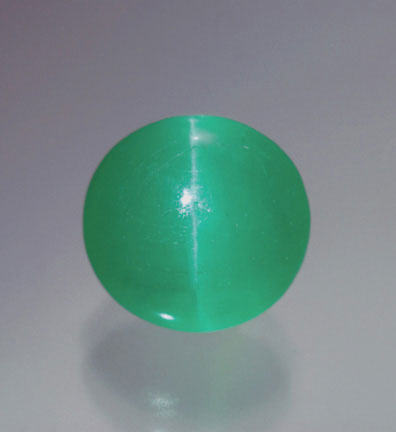 |
| Cat’s eye emerald from Brazil, 4.62 cts., 10.50 x 9.92 x 6.37 mm. This stone has been sold. |
Interested? Select the inventory numbers above, call, or email us. [back to top]
February 21, 2008: Haüyne
Haüyne. Huh?
The origin of the name stems from the French pioneer in crystallography. René Just Haüy lived from 1743–1822 and is considered one of the founders of modern mineralogy. Haüyne is a member of the sodalite family, which also includes lazurite, hackmanite, and sodalite.
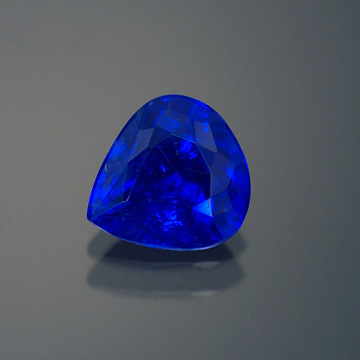 |
| Pear-shaped haüyne, 1.73 cts. This stone has been sold. |
These vivid neon blue haüynes were mined in Germany by some local collectors within the last couple of years. They are from a small quarry in the Mendig lava flow in Niedermendig, in the Eifel Mountains. The color is reminiscent of a blue sapphire or a dark paraiba tourmaline. Also available is a 1.03-ct. oval (this stone has been sold).
Most facetable stones are under 0.2 cts., so the size of these pieces is exceptional.
Interested? Call or email us. [back to top]
January 16, 2008: Multi-Colored Tourmaline
Mozambique Surprise
This month’s featured stone comes from the land made famous for the recent discovery of paraiba tourmalines. Along with the rare occurrence of the element copper, we also find a mix of elements creating a wide variety of colors in the tourmaline family. The multi-colored tourmaline exhibits the unusual nature of tourmaline deposits in Mozambique.
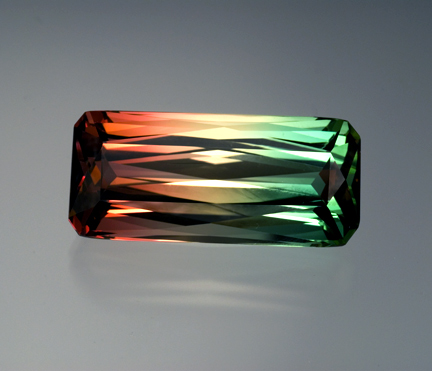 |
| Multi-colored tourmaline, 59.40 cts., 36 x 15.23 x 12.57 mm. Search on inventory number 16129. |
You can imagine the original crystal growing through a metamorphosis of color: first encapsulating all the iron in the green section of the crystal, then introducing a mixture of manganese and titanium to produce the yellow band, and then finally exhausting all the iron and crystallizing the newly introduced manganese chromophore into the tourmaline lattice, which produces the final pinkish-red section. (Don’t quote us on this; our description is a simplification of a complex process that occurs in the genesis of multi-color tourmaline.)
This complex and varying composition must crystallize in unique conditions. The fact that the entire tourmaline emerged flawless after cutting is a true feat of Mother Nature.
Interested? Select the inventory number above, call, or email us. [back to top]
Pala International’s Featured Stones – 2007
Featured in Pala’s Gem News. All photographs by Wimon Manorotkul.
December 16, 2007: Natural Yellow Sapphire
Big and Beautiful
This month’s feature is a full-figured natural beauty. Weighing in at 104.76 carats this healthy and happy sapphire from Sri Lanka is a natural blonde, very clean on the inside and well formed on the outside. This sexy stone is reminiscent of a canary diamond with excellent brilliance and a pure lemon-yellow hue.
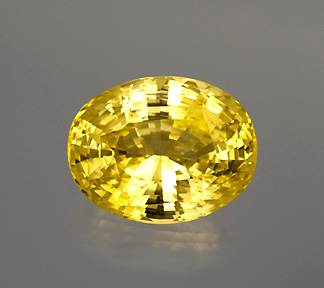 |
| Natural yellow sapphire, 104.76 cts., 30.2 x 23.60 x 16.80 mm. Search on inventory number 14982. |
A perfect companion for a night out on the town or just a cozy winter evening by the fire. She is a handful, but sure to make your dreams come true.
Interested? Call or email us to see if she’s available. [back to top]
November 18, 2007: Star Padparadsha Sapphire
A collector’s choice
Phenomenal gemstones, including star sapphires, surface through in-depth mining efforts and percolate through the hands of gem cutters and merchants, eventually finding their way into the hands of the collector. This month we dig a little deeper down the rabbit hole and find a natural padparadsha star sapphire from Sri Lanka. A phenomenal phenomenon with a peach hue and a nicely formed six-rayed star.
 |
| Star Sapphire, 10.28 cts., 12.64 x 9.84 x 7.34 mm.A fine example of high saturation and crystalline clarity. This stone has been sold. |
Fine star sapphires of any color are quite rare to begin with, captivating collectors of the rare and unusual. The large size, natural pinkish-peach color, translucency, and the presence of the star all contribute to the rarity and desirability of this jewel.
See Pala’s selection of star sapphires here. [back to top]
October 18, 2007: Sri Lankan Taafeite
Taafeite is one of our planet’s extremely rare creations. It is named after its discoverer Count Edward Taafe, a Bohemian-Irish gemologist. Taafeite was originally found mixed within a parcel of mauve-colored spinels. Upon closer examination, it can be easily differentiated from spinel by using a polariscope or dichroscope.
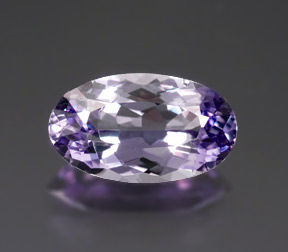 |
| Sri Lankan taafeite, 3.28 cts., 12.23 x 7.24 x 4.82 mm. Inventory #15836. A fine example of high saturation and crystalline clarity. |
Taafeite is known to occur in Russia, China, Burma, and Sri Lanka. According to the Color Encyclopedia of Gemstones by Dr. Joel E. Arem, in 1987 there were around 50 true taafeites that had been properly identified. This month’s beauty comes to us from Sri Lanka, and shows an incredible saturation and a luscious mauve hue. See Pala’s selection of taafeites here.
Interested? Select the inventory link above for pricing, email us, or give us a call. [back to top]
September 15, 2007: Peridot from Pakistan
A common gemstone to some but a real treasure to the purveyors of exceptional gem quality. Peridot is the gem variety of forsterite of the olivine group, and it is found in igneous and some metamorphic rock types. Peridot in its most basic form is a relatively common mineral when looking at the big picture of our Earth. As we trace peridot’s formation from tiny crystals scattered through massive rocks to larger well-formed crystals we began to see the rarity increase. Larger gemmy crystals are quite rare, in fact, and can draw much higher prices than their micro counterparts.
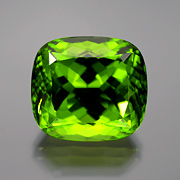 |
| Peridot, 36.70 cts., 19.67 x 17.74 x 13.74 mm. Search on inventory number 15529. (Photo: Wimon Manorotkul) |
In last month’s Pakistan Update, we included a nice 13-carat peridot, and got quite a few “clicks.” This month we feature an exquisite example of big and beautiful. This 36.70-carat Pakistani peridot exhibits some of the most exceptional characteristics of fine material. Super-saturated yellowish-green hue, with flawless clarity, and a precision cushion cut. See more peridot from our inventory here.
Read more on peridot in Pala’s Buying Guide, and the history of its discovery from Peter Bancroft’s Gem & Crystal Treasures,
Interested? Select the inventory link above for pricing, email us, or give us a call. [back to top]
August 15, 2007: Purple Spinel
This month’s featured stone is an unusually intense purple variety of spinel. With the base hue of a fine amethyst, the slight color shift of a sapphire, and the diagnostic dispersion, this spinel is in a class all its own. For more on color shift see April’s featured stone. Also visit our Spinel Buying Guide.
In many respects, spinel is an ideal gemstone. Its wide range of colour, relatively high refractive index, colour dispersion modestly higher than corundum, good hardness as well as lack of birefringence and cleavage raise it above other, even well known precious stones. Spinel definitely deserves to rank next to ruby and sapphire.
– From Gübelin & Koivula, Photoatlas of Inclusions in Gemstones, Vol. 2, p. 662.
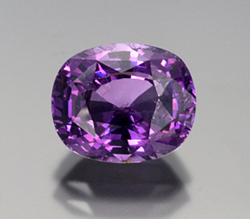 |
| Spinel, 8.13 cts., 10.22 x 9.57 x 6.95 mm. This stone has been sold. |
To further understand external beauty, we must delve internally to see the features that define the genesis of spinel: randomly oriented growth tubes, rutile needles in an obscure phantom pattern, and platelets flashing spectral colors. This phenomenal mix of inclusions and unique appearance is a refreshing sight. Shall we say “by intelligent design”?
 |
| Internal beauty. Needles and platelets flashing spectral colors following the octahedral-like phantom in a micrograph from this month’s featured gemstone. |
Browse Pala’s inventory of spinel. Interested? Email us, or give us a call.
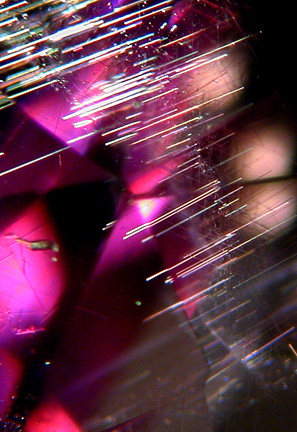 |
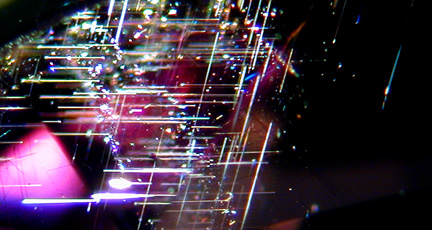 |
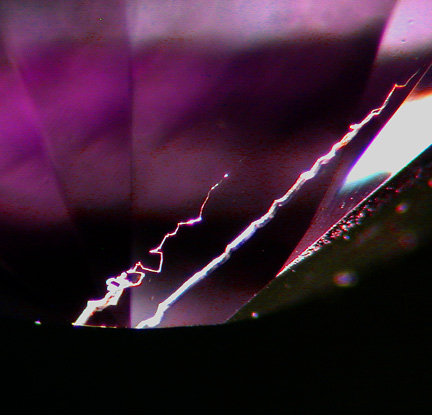 |
[back to top]
July 15, 2007: Fire Opal
Mexican fire opal comes to us with a variety of characteristics. Yellow to deep orange body color with the very unusual hues moving into the reds. Like opal from other parts of the world, Mexican fire opal can display full-spectrum play of color. This month’s phenomenal featured stone has all the components of a top notch collector’s gem.
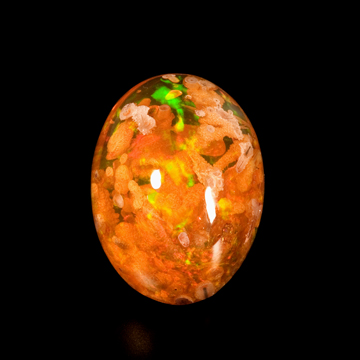 |
| Mexican fire opal, 23.15 cts., 22.99 x 16.93 x 11.82 mm. This stone has been sold. (Photo: Wimon Manorotkul) |
As we look internally, we find another visually stimulating characteristic. Stalagmite and stalactite formations occur within fire opal and are usually composed of goethite rods encrusted in limonite (Gübelin & Koivula: Photoatlas). There also seems to be some hematite crystals inside. See the inclusion photo below for the internal world of this month’s featured stone.
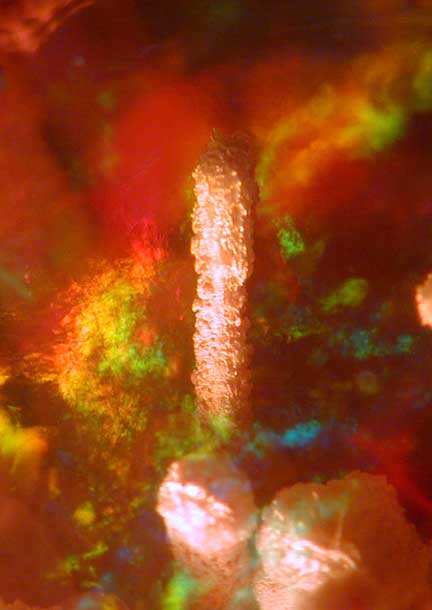 |
| Tiny tower. This single stalagmite formation is one of many found in our intriguing Mexican fire opal. (Photo: Wimon Manorotkul) |
Interested? We have a couple of other exceptional pieces. Email us, or give us a call.
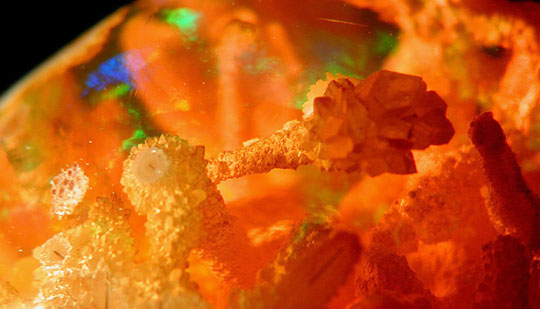 |
| Surreal sceptre. An unusual tube growth formation with larger terminating crystals. (Photo: Wimon Manorotkul) |
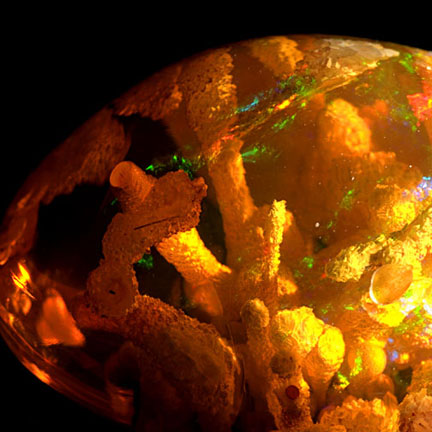 |
| Fire and water. Coral-like stalagmite/stalactite formations are clearly seen in this magnification of this month’s featured fire opal. (Photo: Wimon Manorotkul) |
[back to top]
June 15, 2007: Star Ruby
Star, or asterism, is a phenomenon that appears when light is reflected from oriented inclusions in corundum. These silk inclusions are exsolved needles of rutile, oriented along three directions in a basal plane. Light is reflected and concentrated into bands perpendicular to the three directions; if everything is in alignment inside and outside the stone, a 6-ray star will magically appear. (Adapted from Richard W. Hughes, Ruby & Sapphire, p. 67.)
 |
| Star ruby, 7.53 cts., 10.22 x 9.57 x 6.95 mm. Search on inventory number 13873. (Photo: Wimon Manorotkul) |
This star ruby comes to us from Mogok, Burma. With a pinkish-red hue and good translucency this beauty is a pleasing sight. Beyond the color, the star is very sharp and all the rays are well defined.
Please give us a call regarding this as well as other star rubies we have in stock.
Interested? Select the inventory link above for pricing, email us, or give us a call. [back to top]
May 15, 2007: Russian Demantoid Garnet
Demantoid garnet truly captures the spirit of gemstone collecting. A rare and beautiful gem with provenance and gemological intrigue.
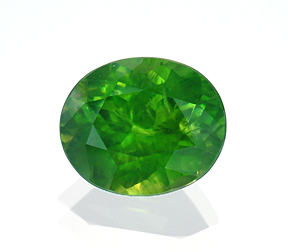 |
| Russian demantoid garnet, 3.69 ct, 10.02 x 8.36 x 5.77 mm. Inventory #14687. A fine example of high saturated green and medium tone. |
Originally discovered in the Ural Mountains of Russia in 1853, these Ural pearls captured the imagination of the likes of reigning Czars, Peter Carl Fabergé, and George F. Kunz of Tiffany’s. The initial mining operations and popularity lasted until about 1919 when demantoid went off the radar. It wasn’t until the 1970s when demantoid resurfaced in limited production along some of the rivers leading out of the Urals. Small scale operations have been sporadic over the last few decades, which included a serendipitous effort by Bill Larson and Pala International to recover some of these green beauties in the late 1990s. Our featured stone this month comes from some of the last premium lots that were coaxed out of the ground.
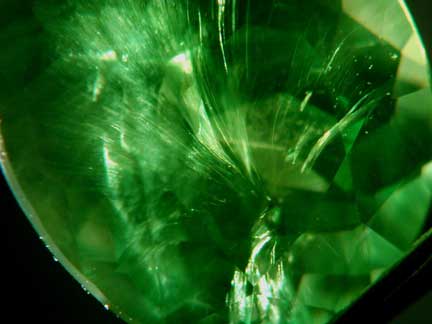 |
| Horsetail inclusion, the identifying mark of excellence—from Russia with love... |
Demantoid is a highly saturated green variety of andradite garnet. The exquisite dispersive properties of this garnet are similar to a diamond, with flashes of color from our visible spectrum. Lighter tones tend to pronounce the dispersion while darker tones show less fire. To further identify these green Russian beauties, most contain horsetail inclusions. These golden byssolite threads occur in curved sprays, resembling horse tails, and are diagnostic of Russian origin.
Demantoid garnets have now been found in Iran, Italy, and Namibia; however the original Russian material seems to hold its place as the finest. With some of the last material available on the market Pala offers a fine selection of demantoid. See the inventory here.
For more information, see:
- Pala’s Gem Spectrum – an issue devoted to demantoid garnet; includes our Demantoid Garnet Buying Guide, by Richard W. Hughes
- Wikipedia on Demantoid
Interested? Select the inventory links above for pricing, email us, or give us a call. [back to top]
April 16, 2007: Madagascar Sapphire
A shift in color...
Sapphire comes to us in many sizes, shapes, colors, and phenomena. Change of color is an optical phenomenon that can be observed as one takes a sapphire from the indoor incandescent light to outdoor sunlight.
Incandescent light is tipped to the longer wavelength end of the visible spectrum, which includes yellow, orange, and red; while sunlight is balanced, emitting the full spectrum. The human eye is sensitive to green light, so we observe more of the blue-green end of the spectrum in daylight, and more of the purple-red under incandescent light.
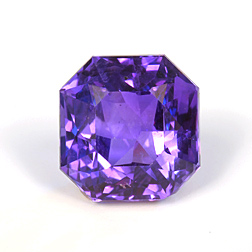 |
| Madagascar sapphire, 3.75 ct., 8.34 x 8.01 x 5.76 mm., radiant cut. Violet-blue color shown in daylight. Inventory #14621. |
In sapphire, this unusual selective-absorption behavior takes place when the stone has a mixture of chromophores. Technically, as Richard W. Hughes has explained in Ruby & Sapphire, these are: (Cr3+), which creates the red/purple component, and (Fe2+ + Ti4+), which creates the blue component.
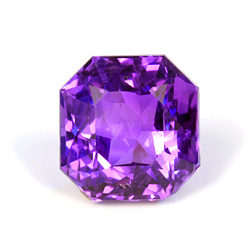 |
| Same Madagascar sapphire as above, shifting to the purple side under incandescent light. |
Change of color can occur as a full color change from green to red, or as a color shift from blue to purple. Color change from one end of the spectrum to the other, aka the alexandrite effect, is rarely seen in sapphires and often is caused by the presence of vanadium. Color shift from blue to purple is more commonly seen and can add a beautiful twist to sapphire. This month’s featured stone is a fine example of this color shift.
Read more on sapphires from the expert, Richard Hughes, at www.palagems.com. And check out Pala President Bill Larson’s “Gods, Graves & Sapphires,” an editorial about sapphire treatment.
Interested? Select the inventory link above for pricing, email us, or give us a call. [back to top]
March 16, 2007: Spinel
The cousin of a king...
Spinel’s popularity has not quite made it to the throne yet, but its rare vivid colors and many varietals definitely make it royalty. Often mined in close proximity to its famous relative corundum, spinel is composed of the same basic elements, aluminum (Al) and oxygen (O), with the addition of magnesium (Mg). With a similar upbringing and a genetic tie to corundum, spinel shines brightly with distinguishing properties. Featuring a higher dispersion, common natural colors, and a lower price point, spinels are being exposed to the discerning collector of regal gems.
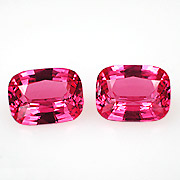 |
| Pair of cushion brilliant red spinels, 3.79 cts. total, 8.3 x 6.4 x 3.8 mm. Inventory #11049. |
Spinels have found their way into some of the world’s most famous gem collections, including the British crown jewels in which a 140-ct. spinel (in the Imperial State Crown) was long thought to be a ruby, and a large assortment in the crown jewels of Russia and Iran.
 |
| Oval brilliant pink spinel from Burma, 7.79 cts., 15.12 x 12.94 x 9.05 mm. This stone has been sold. |
Today fine spinels originate from Burma, Sri Lanka, Vietnam, Tajikistan, Tanzania, and Madagascar. Read more in our Spinel Buying Guide.
Interested? Select the inventory link above for pricing, email us, or give us a call. [back to top]
February 15, 2007: Mozambique Tourmaline
The talk of the town
With everyone talking about paraiba in Tucson, we naturally followed suit with our featured stone this month: a greenish-blue tourmaline, which has a natural copper component that gives it a neon glow.
This Mozambique tourmaline has the “paraiba type” color that was originally made famous by material from Brazil. In general, the Brazilian paraibas are small, included, and unavailable. Luckily the new Mozambique paraibas have a larger size range, are mostly eye clean, and are available—for the time being. Below is a stunning example of how clarity and saturation combine to create a new level for colored stones.
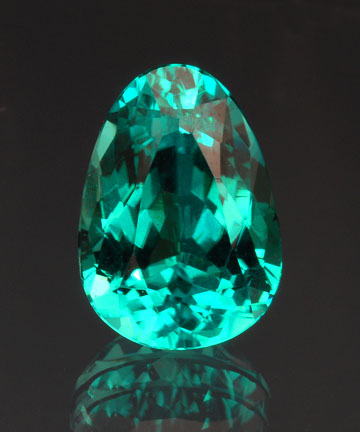 |
| Mozambique tourmaline. Brilliant cut pear shape, 6.73 ct., 14.1 x 10.03 x 7.28 mm. Inventory #14148. |
It’s not very often that something rare and beautiful arrives on the gemstone market. The novelty of these tourmalines was quite apparent at the recent AGTA GemFair in Tucson. Virtually everyone who walked by our booth stopped to take in the view of these emissaries of color. The Mozambique tourmaline is opening up a whole new color palette for gem lovers. This deposit not only has colors reminiscent of Paraiba blue, but also intense greens, lavenders, purples, and everything in between.
Please view the array of colors here. And stay tuned for more on the magnificent Mozambique tourmaline.
Interested? Select inventory #14148 for pricing, email us, or give us a call. [back to top]
January 16, 2007: Kashmir Sapphire
Naturally gorgeous...
As the world becomes seemingly smaller and the scope of mining and production of gemstones grows, we are reminded how truly rare some stones from the classic localities have become. Words like Burmese ruby, Colombian emerald, and Kashmir sapphire are commonly used to describe the finest quality, but to find material that is naturally occurring with saturated color and crystalline clarity is far from common.
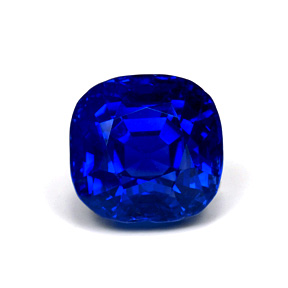 |
| Cushion Kashmir sapphire, 3.30 ct, 7.46 x 7.28 x 6.31 mm. The deep hue of this gemstone is captured against a white background. This stone has been sold. |
 |
| Brilliant! Against a black background the same stone shows its luminous side. Obviously this beauty needs to be seen in person. |
This untreated Kashmir sapphire defines the exception from amongst a seemingly endless supply of commercial quality sapphire. Sapphires are found on most continents but it takes a precise combination of geologic conditions and chemical components to coalesce in the formation of upper echelon gemstones. In other words, this sapphire is rare and naturally gorgeous.
Read more on blue sapphires from the expert, Richard Hughes, at www.palagems.com.
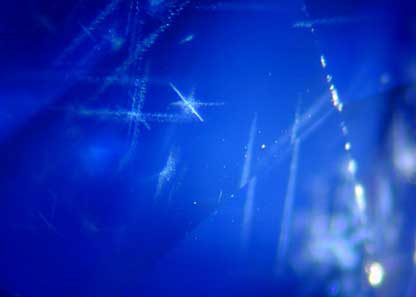 |
| Silk. Needly, cloudlike inclusions, known as silk, are visible under magnification, proof of the absence of heat treatment. |
Come see it for yourself in Tucson. [back to top]
Pala International’s Featured Stones – 2006
Featured in Pala’s Gem News. All photographs by Wimon Manorotkul.
December 14, 2006: Spessartite Garnet
Looks good enough to eat...
Spessartite garnet is a juicy gem, with color that can resemble a ripe orange. In fact, some stones with reddish-orange hues are referred to as mandarin. When plucked and sliced this jewel comes alive with a natural color and a brilliant appearance. A refreshing change from the common dark red garnet, mandarin-type colors are an attractive variety, demonstrating yet another flavor of the garnet family.
 |
| Pear shape spessartite garnet from Nigeria, 5.76 ct, 10.92 x 10.44 x 6.71 mm. Inventory #11929. |
The true mandarin garnets were first put on the collector’s plate from a source in the Kunene River Valley along the border of Angola, in Namibia. Now, beautiful orange material is also coming from Nigeria, Brazil, and more rarely the Ramona mine in San Diego County, California. For more on spessartite garnet, see this Colored Stone article and, of course, our own Buying Guide.
Come sample the fresh fruit at www.palagems.com.
 |
| Round brilliant matched pair of spessartites from Nigeria, 7.79 ct, 9 x 6 mm. This pair has been sold. |
Interested? Select the inventory link above for pricing, email us, or give us a call. [back to top]
November 15, 2006: Brazilian Alexandrite
Ambiguous Alexandrite: The Chameleon of the Gemstone World
Like the chameleon hiding from its prey, the alexandrite shifts color as it moves into the daylight. The observer notices that the gemstone takes on a whole new appearance. Different wavelengths of light excite the crystalline structure in different ways, producing two distinct colors. Whether from a scientific view or an artistic eye the alexandrite is a refreshing sight.
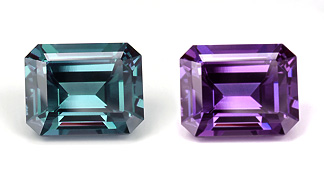 |
| Brazilian alexandrite (daylight at left; incandescent at right), emerald cut, 3.18 ct, 9.06 x 7.23 x 5.1 mm. This stone has been sold. |
This month’s alexandrite is from a fairly new discovery in Brazil (see Gems & Gemology, Spring 1988). The beauty of the Brazilian material rivals that produced by the historic Russian locality. These phenomenal gemstones exhibit medium-dark tones, teal blue to raspberry hues, and strong saturation—properties that define excellent quality and distinct rarity.
Please give us a call regarding other alexandrites we have in stock. [back to top]
October 20, 2006: Natural Pearl
Made in America!!
This month’s featured stone is sure to appeal to the pearl lover in all of us.
When one thinks of beautiful pearls, visions of exotic far off lands such as Malaysia, French Polynesia, Japan......and Mississippi come to mind?
Yes—Mississippi.
When it comes to collecting, one would include pearls from the North American continent. The waters of Tennessee, Baja California, and even less often, Mississippi have produced pearls that can rival their Oriental cousins.
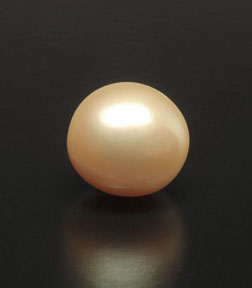 |
| Natural Mississippi pearl. This item has been sold. |
This natural beauty weighs 16.84 cts. and measures a full 14 mm. around. It has a lovely cream base with an incredibly full, satin-peach overtone. A pearl such as this is a rare get for any connoisseur.
Please give us a call regarding other rare pearls we have in stock. [back to top]
September 14, 2006: Purple Tourmaline
These stunning purple tourmalines are yet another example of the fine material coming from Mozambique. It seems we are seeing more and more magnificent colors from this deposit.
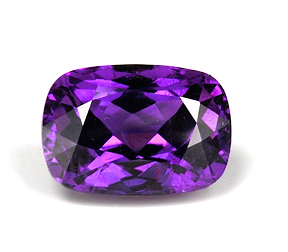 |
| Purple tourmaline, 16.5 ct. This stone has been sold. |
These two stones are both clean, well cut, and show a purple color unlike we have ever seen before. Even more remarkable, both are natural and unheated.
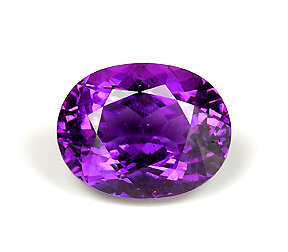 |
| Purple tourmaline, 9.92 ct. Inventory #13731. (Note: In our emailed newsletter this stone was misidentified as an emerald cut 6.61-ct. purple tourmaline, Inventory #13733.) |
Interested? Select the inventory link above for pricing, email us, or give us a call. [back to top]
August 16, 2006: “Paraiba”-type Tourmaline
Copper (Cu) bearing tourmaline is all the rage! Not in many years has a gem material caused so much excitement, confusion, and curiosity as has the “Paraiba”-type tourmalines from the most recent sources of Mozambique and Nigeria.
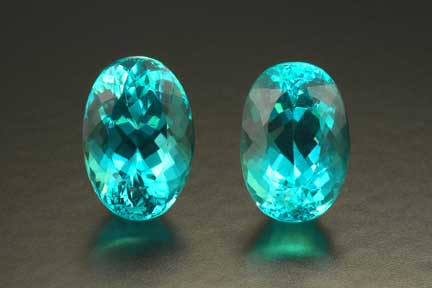 |
This lovely pair of ovals, from Mozambique, has many of the same traits of color and chemical composition as its very popular cousins from Brazil. The two weigh a total of 9.94 cts. See our story about Paraiba tourmaline.
Interested? Email us or give us a call. [back to top]
July 20, 2006: Aquamarine
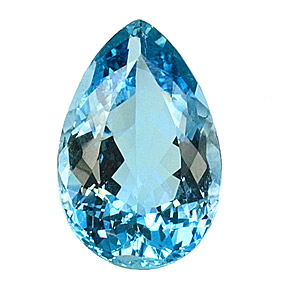 |
Our featured stone is an exceptional aquamarine from antiquarian jewelry, most likely from Santa Maria, Brazil. The immutable aqua color of this gemstone is devoid of the gray found in lesser stones. We dare you to find a finer, darker aquamarine available on the market today.
At 37.60 carats (29.9 x 19.6 x 12.2 mm) this rare stone is perfect for either pendant or investment. The price is available upon request. [back to top]
July 4, 2006: African Zircon
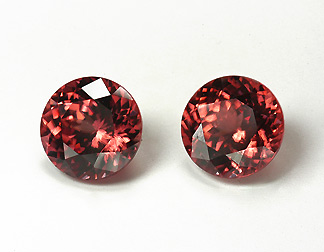 |
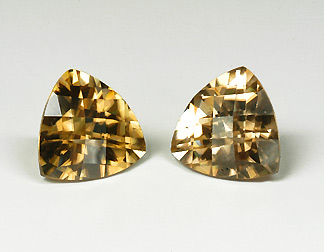 |
As demonstrated by our last two featured stones, Africa offers a wealth of various gem materials from all regions. Naturally occurring zircon has a brilliance and refractivity very much like that of diamond. Often confused with zirconia, zircon is most well known in yellows and brown-yellows, but new material of unusual and scintillating colors is what we present to you this month.
The zircons pictured above (top, 5.91 ct.; bottom, 10.96 ct.) are examples of the latest colors being produced from Kenya and Tanzania.
Prices are available upon request. [back to top]
May 22, 2006: Imperial Garnet
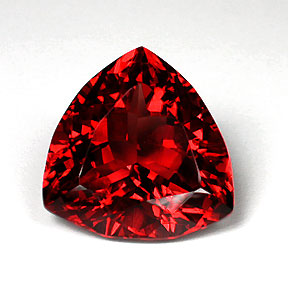 |
This unusual pyrope-spessartite garnet is the latest in beautiful and rare gem materials to be unearthed from the Lindi Province of southeastern Tanzania.
What makes this particular stone so special is its size. Marketed as “imperial” garnet, it is reported that most such material suitable for cutting is rarely over one carat in size, and inclusions are common. This incredible “gem” weighs 57.12 carats and has an amazing, intensely saturated combination of rich orange with a crisp pink secondary that indeed gives it a color similar to fine imperial topaz. The clarity is exceptional and the cutting is superb.
The price is available upon request. [back to top]
April 17, 2006: Chrysocolla
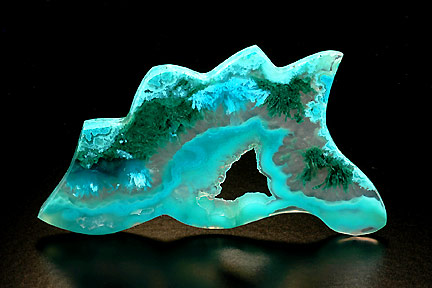 |
This month we bring you a sampling from our inventory of chrysocolla, consisting of both cabochon-cut and uniquely carved pieces. The 63.99-ct piece pictured above is from material found in the 1950s and cut by Bud Standley. It features an attractive agatized pastel blue band and a small druzy window.
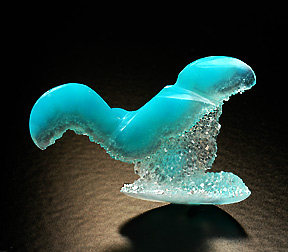 |
| Inventory #12092. |
The second piece above, 16.46 cts., is another great chrysocolla, perfect for custom-made jewelry. It is masterfully carved to show off both its color and the delicate druzy area.
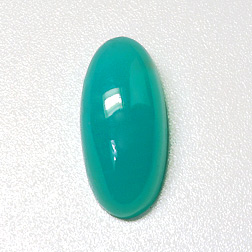 |
| Inventory #4880. |
Finally, a fine translucent cabochon with an even pastel blue, 7.63 cts. Simply exquisite. These are just a few of our unique pieces. Prices are available upon request. [back to top]
March 9, 2006: Blue Tanzanite
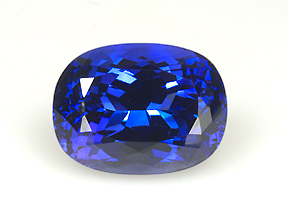 |
Since its history-making discovery in 1966, most deep-blue-color tanzanite in the market today is the result of heat treatment. Most of the time... This 47.43-ct. “gem” was cut from the amazing unheated natural-colored crystal seen below, which weighed 114.67 cts. before cut. |
The stone, the rough of which was acquired at this year’s show in Tucson, is a vivid blue with intense trichroic flashes of violet and red; often compared to sapphire. A natural tanzanite of this size, with documentation of its “before cut” state is a rarity. When the time came for cutting a crystal of this caliber, we chose to entrust the stone’s fate to the eye of master cutter, Raphael De Gottrau, of Raphael’s Lapidary in Scottsdale, Arizona. We are happy we did. The price for this blue tanzanite is available upon request. [back to top] |
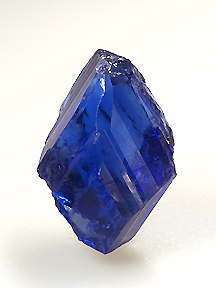 |
January 16, 2006: Alexandrite
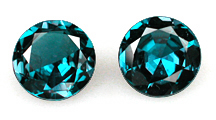 |
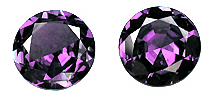 |
Our featured stone this month is alexandrite, from the chrysoberyl family. This outstanding matched pair is from Brazil.
These stones, 2.48 carats combined, possess a strong color-change effect, the primary qualification for labeling a chrysoberyl alexandrite. The change is from fine bluish green in daylight to raspberry/rhodolite in incandescent light.
See Inventory #12886. For more information on color-change properties visit our Palagems.com Alexandrite Buying Guide. [back to top]
Pala International’s Featured Stones – 2005
Featured in Pala’s Gem News. All photographs by Wimon Manorotkul.
December 15, 2005: Green Tanzanite
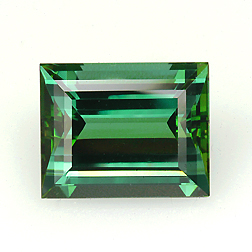 |
In our last featured stone presentation we introduced you to a unique mint-colored garnet from the Merelani mining district in Tanzania. This month we return to Tanzania to acquaint you with the most rare of tanzanites.
What would make this stone any rarer than other tanzanite? you might ask. The color, for one thing: at first glance you might not even guess that it is a tanzanite at all.
Due to chromium, this material produces tones that are predominantly green with subtle blue overtones in contrast to the more familiar royal violet/blue tones, derived from vanadium. Green tanzanite is rarely seen in jewelry stores and is sought in large sizes by many gemstone aficionados and collectors.
When mining, it is rare to find any material that will produce something larger then 5-carat sizes. This beauty tips the scales at approximately 9.5 ct. and displays exceptional clarity. Please give us a call if your client/collector wishes to add a gem of this type to their portfolio. Price available upon request. [back to top]
November 15, 2005: African Mint-Colored Garnet
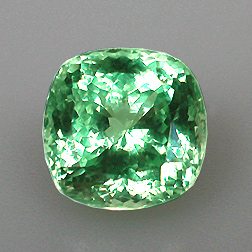 |
Kenya and Tanzania have long been regarded as producers of some of the world’s finest colored stones. This mint colored-garnet is of the grossular variety and is particularly lovely with its delicate blue/green tone that is very brilliant when cut properly, as it is here. The northern Tanzanian mining area of Merelani, where this material is found, is also the magnet that has drawn tanzanite dealers for years.
The mint-colored garnet material is difficult to find in fine, crystalline form, and its size is always relatively small. It is often considered a softer companion to its big and more well known relative, Tsavorite garnet.
This gemstone weighs 7.14 carats and measures 10.5 x 10.5 mm. The hardness makes it a great everyday-wearing stone. This stone has been sold. [back to top]
October 6, 2005: A Special Gemstone
This pale pink poudretteite was found in the Mogok district of Burma. It is one of less than ten known faceted stones.
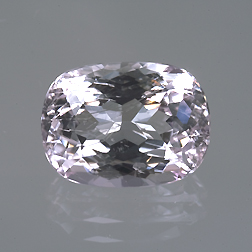 |
It weighs 3.8 carats and measures 11.4 x 8.4 x 6.7 mm. Price available upon request.
Further information about poudrettite can be found in Gems & Gemology, Spring 2003, Volume 39, Issue 1, pp. 24-31. [back to top]
September 22, 2005: Imperial Topaz
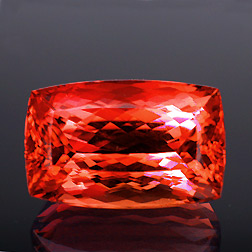 |
What’s in a name?
This 14.37-carat gem “Imperial Topaz” is the perfect example of what an imperial should look like.
This stone has a combination of fiery red, mixed with a brilliant orange and just the right splash of peach to bring it to the top of the list of the most desired topaz colors, second only to a true red, which has proven to be the rarest color to find in gemmy material.
It weighs 14.37 carats and measures 16.5 x 10.7 x 8.8 mm. This stone has been sold. We invite you to call us about imperial topaz to help you complete that perfect piece. [back to top]
August 15, 2005: Unusual Spinel from Tanzania
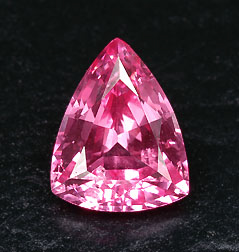 |
This beautifully cut gem spinel hails from the unusual location of Tanzania. Most aficionados of gemstones know Burma to be the classic and most familiar source for fine spinel… until now. In the past most spinels from Tanzania displayed a somewhat hazy appearance, what we refer to in the business as a “sleepy” overall look. This gemstone has a limpidity and brilliance that defies verbal description. And then there is the color!
This amazingly crystalline, perfectly cut, untreated natural “gem” is a perfect combination of fiery pink with a kiss of orange.
It weighs 2.39 carats and measures 9.7 x 7.7 x 4.9 mm. This stone has been sold. We invite you to call us about any of our other stones to help you complete that perfect piece. [back to top]
May 28, 2005: 16.16-carat Zircon
Pala International President Bill Larson’s most recent trip to Burma and Bangkok turned up this very clean blue Zircon.
This Cambodian stone features a fine, rich, bright blue with no green. The excellent cushion cut contributes to one of the finest stones of its kind to be procured by Pala.
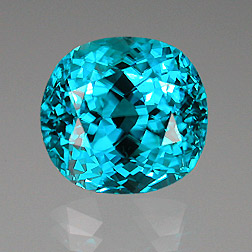 |
Interested? Search on Inventory #11628. Or call us about this or any of our other stones. [back to top]
See other: